Greetings and welcome to our first-ever panda blog! For those of you who are new to Zoos SA, Adelaide Zoo is lucky enough to house the only two Giant Pandas in the southern hemisphere – Wang Wang (meaning Net Net) and Fu Ni (meaning Lucky Girl). This beautiful pair came to us in December 2009 to take part in the global conservation program in an effort to save this unique species from extinction.
Now in their fifth year at Adelaide Zoo, we’re often asked why they have still not bred. It’s extremely important to remember that being the first pair of Giant Pandas to reside in the southern hemisphere, we have a very unique situation, and a world first. Firstly, living in the southern hemisphere, they are six months completely opposite to every other panda in the world! While we enter our yearly breeding season, the northern hemisphere is currently experiencing a very busy birthing season. Secondly, because this is a world first, Adelaide Zoo was provided with two sexually immature Giant Pandas who could grow and develop into the southern hemisphere’s seasons. Therefore, at the time of their arrival neither Wang Wang nor Fu Ni had ever been exposed to breeding situations, which means it was always going to take them a lot longer to learn and develop these behaviours.
This unique setup has presented us with something different every year. In the early years of breeding seasons, the pair was more interested in playing together, wrestling with one another – behaviours consistent with younger pandas. Then we witnessed Fu Ni’s change in maturity, displaying more interest in Wang Wang, but he unfortunately was still not quite mature enough to pick up on these signals and was only keen to continue the wrestling matches.
Last year we were extremely pleased with the behaviours we observed, both pandas showed more mature breeding behaviours, while Wang Wang in particular was much more dominant in his interactions with Fu Ni. It was very exciting to see how much progress the pair has made since their first breeding season in 2011 and know the behaviours we observed last year put us in good stead for the upcoming breeding season.
This year, we’ve been seeing some of the initial breeding season behaviours for the past few months. For Wang Wang, these behaviours include an increase in scent marking (the depositing of a special secretory substance that provides messages for other pandas) and rutting (focused power-walking around the territory, smelling and scent marking while doing so). While for Fu Ni, we have also witnessed scent marking, an increase in fussiness for her bamboo, an increase in sound and light sensitivity, and overall restlessness.
We are now eagerly awaiting the onset of the next stage of breeding season. Female Giant Pandas come into season with the increase in day length and temperature, but also require more clear, sunny days, in comparison to cloudy, overcast days. The next stage will be characterised in Fu Ni by a significant increase in scent marking (changing from one to two scent marks a day to 50-100 scent marks a day), she’ll also start playing in water, and spending a greater amount of time up the trees within her habitat.
While we can compare these behaviours with previous years, we also need to keep in the back of our mind that Fu Ni is another year older and could come into season a lot quicker than she has done in previous years. We’ll be keeping a very close eye on these behaviours, as they’re our best indicator, along with physiological changes, as to how close she may be to ovulation. We then combine these observations with hormone analysis from urine samples and cellular compositions from vaginal cytology to pinpoint the exact moment the brief 36 hour fertility window of ovulation begins.
It’s an understatement to say how excited we all are for the upcoming season. Regardless of whether the season is deemed successful or not, being inexperienced, the pandas may just need this extra time to work on their natural behaviours with one another, and no matter what, they’ll continue to be a symbol of conservation not only for their own species, but for all wildlife.
Lucy Catt
Acting Senior Panda Keeper, Adelaide Zoo








